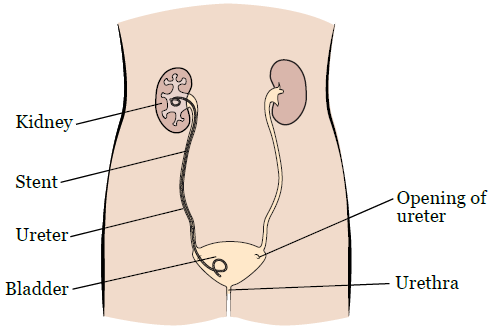This information will explain what a ureteral stent is. It will also tell you what to expect during your ureteral stent placement procedure at Memorial Sloan Kettering (MSK).
About Your Ureters and Ureteral Stent
Your ureters are tubes inside your body that drain urine (pee) from your kidneys to your bladder. If one of your ureters is blocked, your urine won’t drain properly. When this happens, your kidney fills with urine and swells. This is called hydronephrosis. It can be caused by a tumor pushing on your ureter, kidney stones, or scar tissue. If your kidney remains blocked for a long period of time, it can become damaged. If both of your ureters are blocked, this will cause both of your kidneys to become weak and can place you at risk for kidney failure. Blocked kidney(s) require ureteral stent placement.
A ureteral stent is a thin tube that’s placed in your ureter to help drain urine from your kidney (see Figure 1). One end of the tube is inside your kidney and the other end is in your bladder.

Ureteral stents can be used for several weeks, months, or years. They’re used to:
- Let urine flow through your blocked ureter.
- Keep your ureter open.
Before Your Procedure
Before your procedure, your nurse will teach you about what to expect during your ureteral stent placement. They’ll also give you information about how to get ready for your procedure. Be sure to follow the instructions they give you. Call your healthcare provider’s office if you have any questions.
During Your Procedure
On the day of your procedure, a nurse will place an intravenous (IV) line in one of your veins. You’ll get fluids through your IV. You’ll also get medication to help make you more comfortable during your procedure.
To place the stent, your healthcare provider will first insert a cystoscope (thin, metallic tube with a camera) through your urethra (the small tube that carries urine from your bladder to outside your body) and into your bladder. They’ll use the cystoscope to find the opening where your ureter connects to your bladder. Once they can see this opening, your healthcare provider will thread a ureteral stent through the cystoscope and into your ureter. After the stent is in place, the cystoscope will be removed.
After Your Procedure
In the hospital
After your procedure, you’ll be taken to the recovery area, called the Post-Anesthesia Care Unit (PACU). A nurse will check your pulse, breathing, and blood pressure regularly. If you feel any pain, your healthcare provider may prescribe pain medication to help you feel more comfortable.
You’ll stay in the PACU until you’re fully awake. Once you’re awake, your nurse will go over your discharge instructions with you before you go home.
At home
It’s important to drink more water than usual for the first 24 hours after your procedure. Drink 8 to 10 (8-ounce) glasses of water.
Don’t do any physically demanding activities for the first 24 hours after your procedure. Examples of demanding activities include lifting objects heavier than 15 pounds (6.8 kilograms) or any activities that use your abdominal muscles (abs). After 24 hours, you can go back to doing your normal activities.
While You Have Your Stent
After your stent placement procedure, you may feel a “pulling” sensation when you urinate (pee). You may also have:
- Frequent urination, which is the need to urinate more often than usual.
- Urgent urination, which is a strong, sudden urge to urinate, along with discomfort in your bladder.
- Pelvic pain, which is pain in your lower abdomen (belly).
These symptoms usually go away with time. Your healthcare provider will talk to you about what symptoms you might feel. Your healthcare provider may give you medication to help with bladder symptoms.
You may sometimes see blood in your urine while you have the stent. This may happen for as long as the stent is in place. Sometimes, it happens after increased activity or long car rides. If you see blood in your urine, drink more water than usual until the blood goes away.
Stent replacement
Your stent will need to be replaced about every 3 to 6 months. Your healthcare provider will tell you when it needs to be changed. Leaving your stent in place for too long can lead to:
- Your ureter becoming blocked
- Kidney stones
- Infection
When to Call Your Healthcare Provider
Call your healthcare provider if you have:
- Chills.
- A fever of 101 °F (38.3 °C) or higher.
- A burning feeling during urination.
- Cloudy urine.
- A foul smell to your urine.
- Pain on either side of your abdomen, or kidney area.
- Any questions or concerns.